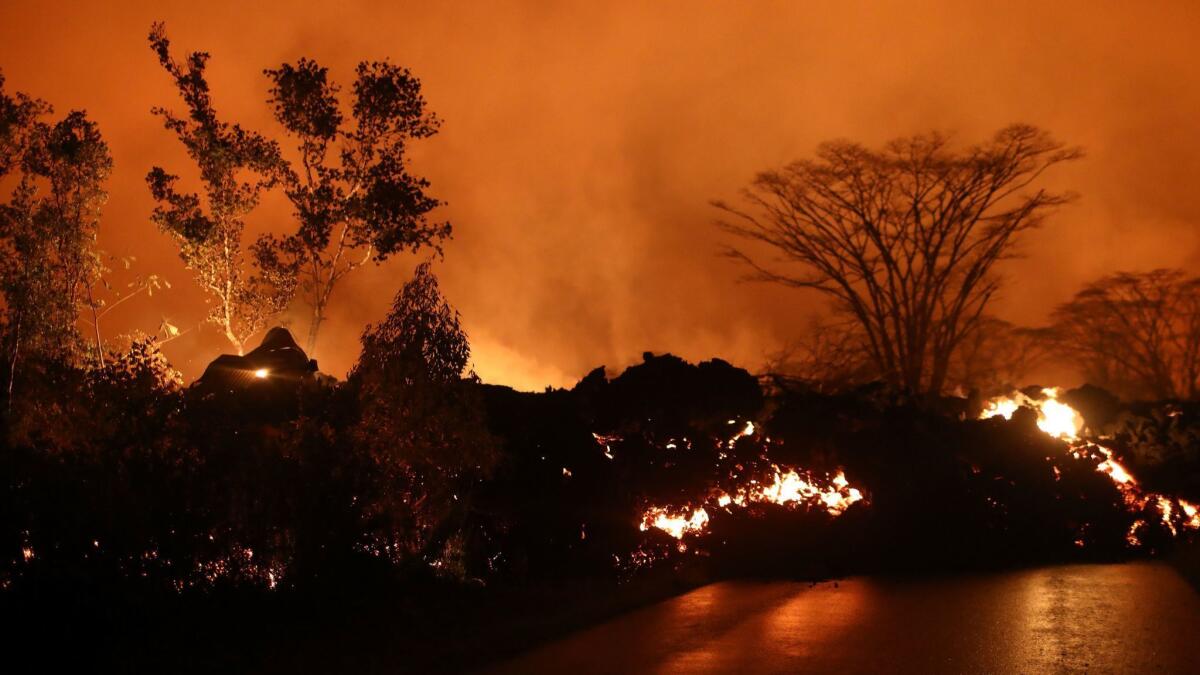Hawaii assures travelers it’s open for business as erupting volcano makes tourists skittish

- Share via
Reporting from HONOLULU — The images of the Kilauea volcano erupting on Hawaii’s Big Island have captivated the world with their power and fury — lava shooting into the air, swallowing a car, pouring into the sea. The images are dramatic, but also disconcerting.
“I was a little scared, especially since we have two young girls. We didn’t know if the air quality would be affected,” said Christine Arrabaca of Villa Park, Calif.
“Everywhere you look on the media, you can’t miss seeing news clips of the volcano eruption,” added her husband, Kevin Arrabaca. Still, the family flew out to the island of Oahu to spend Memorial Day weekend at the Royal Hawaiian hotel. They’re glad they did.
“The ocean has never been bluer, and the weather has been amazing,” said Kevin Arrabaca, taking in the view of Waikiki Beach with his family.
Tourism and state officials are hoping for more people like the Arrabacas. The state estimates the volcano has already cost Hawaii millions in tourism dollars, and industry experts say they are hearing of cancellations made by skittish tourists.

The state now has the tricky task of reassuring the wider world that Hawaii is safe and open for business while also providing swift public safety updates for the small portion of the island affected by the eruption that started May 3.
Public safety is a particularly touchy subject in Hawaii these days. In January it took the state about 38 minutes to officially say that an electronic alert warning of an incoming ballistic missile attack — “THIS IS NOT A DRILL” — was sent by mistake. Hawaii Gov. David Ige and his administration were pummeled with criticism after the debacle.
At Kilauea, fissures are opening in the middle of neighborhoods, Ige noted, which leaves little time to warn people and evacuate them.
Currently, 22 fissures have opened, and several are active, creating spectacular scenes of lava fountains and lava flowing into the ocean.
So how do you warn the public about the potential for disaster without scaring everyone to death?
“I believe in transparency, so we provide the most current information that we can to the community about the location of the fissures, the gas readings that we’re having, so that they can be fully aware,” Ige said. “There is a trust I think that has developed between the emergency workers and the community.”
So far, lava has destroyed 82 structures, including 41 houses. In addition, 37 structures have been surrounded by lava, so access to them is cut off, according to Janet Snyder spokeswoman for the Hawaii County mayor’s office.
“It’s heartbreaking to speak with individuals who have lost their homes,” said Ige, just back from meeting with residents affected by the eruption. “Our primary concern is to ensure that we keep our community safe.”
Officials don’t know exactly how many people have been evacuated, but said around 2,100 people lived in the area before the eruptions occurred.
“It definitely keeps me up at night,” Ige said.
But the governor believes there are misperceptions — that the volcanic eruptions are threatening the entire state. So along with tourism officials and other community leaders, he’s encouraging people to visit all the Hawaiian Islands, including Oahu, Kauai, Maui, Molokai and Lanai.
“It’s still great to visit Hawaii Island. The eruption site is just a very small portion of the island, less than 1% of the island is impacted by the volcanic eruptions,” Ige said, adding that Hilo, Pahoa, and the Kona and Kohala coasts, where most of the resorts are, are open for business.
Scientists say the volcanic activity is not over yet. So the state’s top tourist attraction, Hawaii Volcanoes National Park, remains mostly closed and won’t reopen until safe to do so. According to a recent report, park visitors poured $166 million into the island economy last year, said Jessica Ferracane, spokeswoman for the park.
As of Monday, state officials estimate, the local economy will have lost about $8 million because of the park closure.
“Clearly, vacation rentals and businesses in the area near where the lava flows are occurring have been adversely affected. However, for the rest of the island, particularly the resort areas, it is difficult to get an accurate read as to if, or how, many cancellations have actually occurred,” said Ross Birch, executive director of the Island of Hawaii Visitors Bureau.
State and tourism officials have repeatedly noted that the Big Island lives up to its name, covering more than 4,000 square miles. State officials estimate lava has spread over about 3 square miles so far.
Among the troubling images beamed across the world have been videos of “laze” — lava haze — the white acidic plume created when lava hits the ocean. Officials warned of its hazards but stressed it can only affect those nearby.
The Hawaii Tourism Authority released a statement by Wendy Stovall, deputy scientist-in-charge at the Yellowstone Volcano Observatory, about the danger. “Laze is being misconstrued. … It’s not going to travel around the island, float to other areas. Not a reason for people to cancel their trips.”
Images of the volcanic eruptions have not bothered visitors like Dennis Rogers. “What the viewers see may be the most dramatic images, like the golfers with the huge plume of ash behind them. People may think that it’s worse than it is. It’s quite a spectacle to see a volcano erupt, with all the lava flowing, but for me I had no concerns because I know the islands,” said Rogers, director of communications for the Los Angeles Clippers. He is visiting Maui and Kauai with his wife over the long holiday weekend.
Back on Oahu, the Arrabaca family seemed pretty happy about its decision to come to Hawaii and stay at the Royal Hawaiian for the first time. Since their daughters, 4-year-old Morgan and 2-year-old Mia, both like pink, they chose to stay at the pink hotel, which is also known as the Pink Palace of the Pacific.

There’s no flowing lava around here. But the mai tais were flowing over at the hotel’s famed Mai Tai Bar. That’s where Raymond Nieto and Sandy Khamiseng of San Jose were enjoying their view of Diamond Head.
“The images of the volcanic activity definitely caught my attention and raised an eyebrow or two,” admitted Nieto. But once he got on Twitter and realized that no one was panicking on Oahu, and it was business as usual, he booked their trip.
“It’s been really relaxing lounging on the beach,” Khamiseng said.
Chang is a special correspondent.
More to Read
Sign up for Essential California
The most important California stories and recommendations in your inbox every morning.
You may occasionally receive promotional content from the Los Angeles Times.










